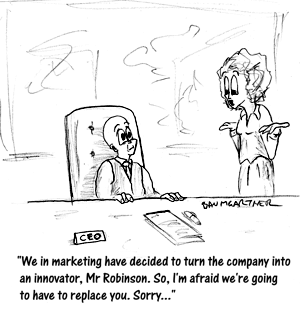
How To Make Your Big Company Super-Innovative in One Easy Step
By Jeffrey Baumgartner
When big companies want to innovate these days, they tend to do all kinds of things such as: including the word "innovate" and its variations on corporate literature; promoting managers to be innovation managers; investing in idea management software; and running creative thinking events such as brainstorms and anticonventional thinking sessions. While these actions can all lead to improved innovation, the improvement is limited. If a company really wants to become an innovation powerhouse, there is one simple action they can take: fire the CEO and hire a new one with a focused vision.
Let us look some examples.
IBM
For decades, IBM was the global leader in computers. When companies bought computers, which until the late 70s were massive machines that cost a fortune, they almost inevitably bought IBM products. Indeed, it was often said that "nobody ever got fired for buying IBM equipment." Not surprisingly, the company did very well for a long time.
However in the 1980s, the personal computer (PC) was became increasingly popular and increasingly powerful. Within a few years, the Internet allowed those PCs to connect with each other, bringing to small computers many of the benefits of big machines, but at a fraction of the cost. As a result, the market for big machines collapsed and IBM was bleeding money. Something had to be done to save the giant. For the first time in history, it hired an outsider: Leo Gerstner whose experience was not in technology. Rather he had led companies including Nabisco (food) and American Express (credit cards).
Mr Gerstner shook up IBM, closing outdated divisions, establishing new customer-oriented divisions and focusing on providing a relevant and comprehensive range of products and services for the new, PC networked based business world. (Source)
Apple
In 1985, Steve Jobs, who co-founded Apple, resigned following a boardroom dispute. For the next decade, Apple lost market-share and prestige. Although graphic artists embraced it, the rest of the world felt that Microsoft's Windows operating system was not only just as good, but it was cheaper and worked with a wider range of applications. Apple soon found itself in a bad way.
In 1997, Steve Jobs was rehired as interim CEO and he never left. He promptly focused Apple's product range on sleek, beautiful and well engineered products that could be sold at premium prices. More people again took pride in owning Apple. Eventually, the company expanded beyond PCs to the iPod, iPhone and iPad. The company is now incredibly profitable. (source)
Nokia
Nokia was founded in Finland in 1865 and over the next century became a sprawling conglomerate with an incredible range of activities, from lumber to consumer electronics to telephones. In fact, the range of activities was too wide. By the 1980s, the company was bleeding money so badly, the CEO was driven to suicide. A replacement CEO tried to organise operations, but it was still too much and the company remained in trouble.
In 1991, Jorma Ollila was promoted to CEO. He promptly sold off or shut down all of Nokia's divisions that had nothing to do with mobile telephony and transformed Nokia into the 90s most innovative and successful mobile telephone company. Sadly, for Nokia, the company lost its competitive edge as smartphones became the rage and Apple, Samsung and others took the lead in the market. Perhaps not coincidentally, Mr Ollila retired in 2006. (Source)
Vision
In all of these examples, diverse, unfocused companies were in economic trouble. They replaced CEOs with innovators who focused operations on a particular vision and kept that focus. Product development, hiring, manufacturing, marketing and communications all focused on that vision which meant that innovation also focused on the vision. In the 90s, no one in Nokia wasted time with ideas for cheap TVs or improved efficiency of transporting lumber. No. Ideas focused on making ever better, smaller, more useable GSM telephones.
Of course, that does not mean that dumping your CEO will automatically result in innovation. Most CEOs, old or new, are reluctant to focus because it means getting rid of operations, divisions and often employees. It is perceived as risky: what if the focused business fails? What will the company fall back on? Moreover, by selling assets and closing down operations, the CEO is reducing her power base. Temporarily, she has less than she had when she started. That's a hard thing for a powerful person to do.
Nevertheless, I do not know of any examples of long-term, sitting CEOs who have radically shaken up their companies, sold irrelevant divisions and brought a visionary focus to operations.
What this means is that if you want to transform your company into an innovation powerhouse, you will have to dump the CEO and replace her with a focused visionary. But, there's no need to tell your unwanted CEO that it was my idea - okay?




